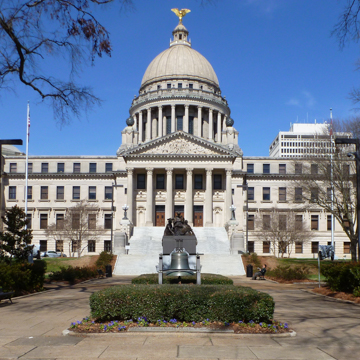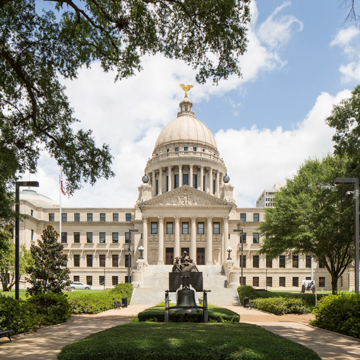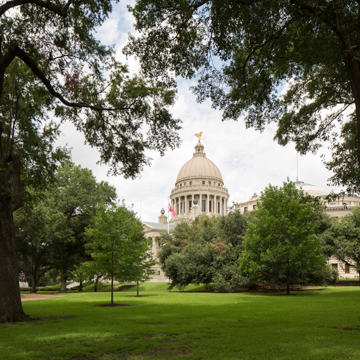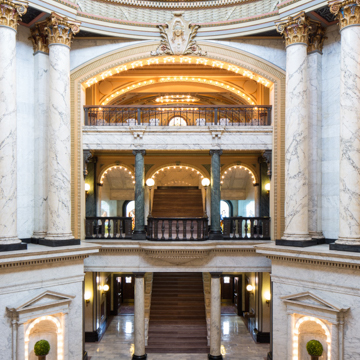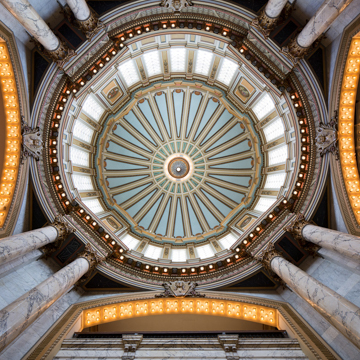Mississippi's magnificent Beaux-Arts classical capitol emerged from an uncommonly speedy building project for such an important institution. In February 1900, needing to replace the overcrowded Old Capitol and with a $1 million tax settlement from the Illinois Central Railroad, the legislature chose the four-block site of the 1840 state penitentiary (which was then demolished for the new capitol) and established the State House Commission led by Governor Andrew H. Longino. On April 9, fourteen architects nationwide—but none from Mississippi—presented their plans. Finding itself "very much in doubt as to the relative merits of these plans," the commission hired Bernard R. Green of Washington, D.C., the engineer of the Library of Congress, to advise them. Upon Green's recommendation, the commission hired Theodore C. Link of St. Louis, a German immigrant trained in Paris, who had won renown for his design of Union Station (1894) in St. Louis. Green's suggestions to Link included heightening the dome, illuminating the corridors with skylights and glass-block floors, and adding a porte-cochere.
Link explained his vision for the capitol upon its dedication in June 1903: "The style adopted is a pure renaissance classic of dignity and elegance of proportion which will fittingly express the power, honor, and stability of the State." Characterized by monumental scale, symmetry, and an emphasis on functional interior planning, the classical Beaux-Art scheme Link described both camouflaged and exploited new technologies like steel framing and electricity.
Six feet of fill added to the site to stabilize the Yazoo clay soil provides a base for the massive building. The five-part symmetrical form, inspired by the U.S. Capitol, is composed of a central block connected by wings to projecting end pavilions, each of which have semicircular end walls. A heavy modillioned cornice acts as a unifying force. The minor domes over the Senate and House create a visual progression up to the central dome, which is carried on a tall drum encircled by Ionic columns. The principal facade faces downtown and is dominated by a projecting pedimented Corinthian portico and staircase. A bas-relief tympanum sculpture symbolizes the culture and economy of the state, Mother Mississippi at its center with her foot on a bale of cotton.
Builders W. A. and A. E. Wells of Chicago constructed a steel-framed structure strengthened with brick, and the dome also has a steel frame; lightweight terra-cotta clads the dome. Electric light bulbs, exposed and used decoratively in the rotunda and chambers, delighted the crowds that attended the building's first illumination in June 1903.
The interior's decoration completes the composition and fulfills what Link saw as the public building's educational mission. Louis Millet of Chicago designed and installed the stained glass windows and ceiling panels that infuse the building with changing light. The interior was finished with polychromatic marble, scagliola, and tile, but the ceilings remained unpainted as a cost-saving measure until 1934 when a Civil Works Administration (CWA) project overseen by Overstreet and Town brought the colorful murals now seen in the major spaces.
By the 1970s, the capitol’s offices were crowded with cubicles and the building suffered from deferred maintenance. A systems overhaul and restoration of the public spaces lasted from 1979 to 1982. Oversight since 1999 by the Mississippi Department of Archives and History's Curator of the Capitol has helped maintain the capitol's architectural integrity and beauty. The building was designated a National Historic Landmark in 2016.

